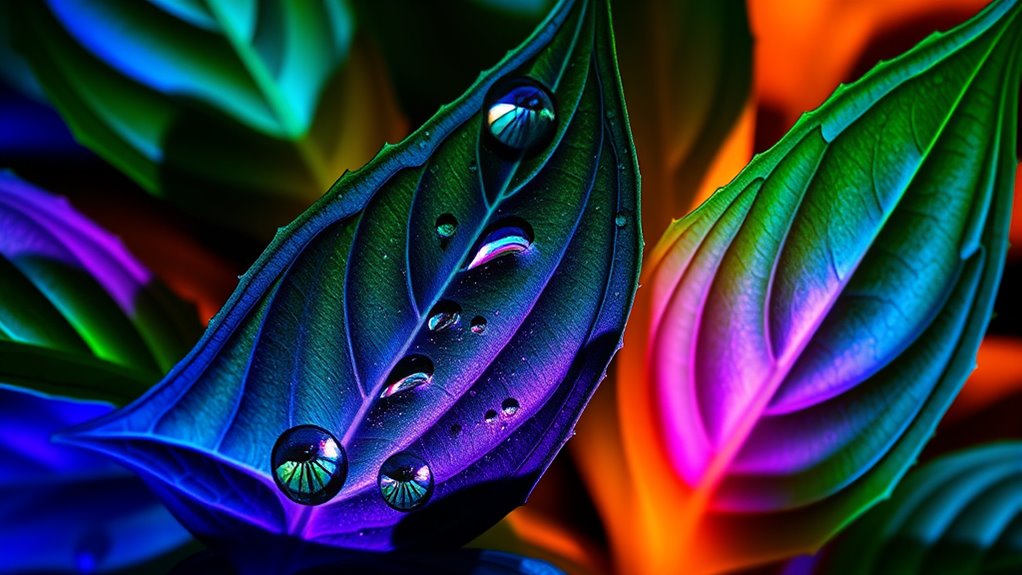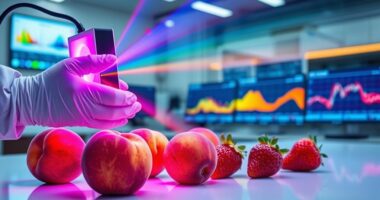To optimize light for leafy greens, you need to tailor your spectrum to each growth stage by balancing red and blue wavelengths. During seedlings, boost blue light for strong roots and leaf development, while mature plants benefit from increased red light to enhance leaf expansion and biomass. Fine-tuning these recipes can improve growth speed, flavor, and nutritional content. If you keep exploring, you’ll find strategies to create perfect light setups for every phase.
Key Takeaways
- Customize light spectra to match growth stages, using more blue light during seedlings and increased red light for mature greens.
- Balance red and blue wavelengths to maximize photosynthesis, leaf expansion, and nutrient density.
- Use spectrum tuning to optimize flavor, color, and overall nutritional content of leafy greens.
- Adjust light recipes to improve growth speed, plant health, and resource efficiency throughout cultivation.
- Employ modern LED fixtures with adjustable spectra for precise control and experimentation in leafy green production.

Harnessing the right spectrum of light can substantially boost the growth and quality of leafy greens. When you optimize your lighting setup, you directly influence photosynthesis efficiency, which is essential for healthy, vibrant plants. By tailoring the LED spectrum customization to suit leafy greens, you can enhance their overall development, flavor, and nutritional content. The key lies in understanding how specific wavelengths of light affect plant processes and adjusting your LED fixtures accordingly.
Photosynthesis efficiency depends heavily on the light spectrum plants receive. Leafy greens primarily utilize red and blue wavelengths, which drive their growth and chlorophyll production. Red light, in particular, stimulates flowering and leaf expansion, while blue light encourages compact growth and strengthens stems. When you fine-tune your LED spectrum, you provide just the right balance of these wavelengths, ensuring your plants maximize their photosynthetic potential. This optimized spectrum leads to faster growth rates, better leaf coloration, and improved nutrient density.
Optimizing LED spectrum balances red and blue wavelengths to boost leafy greens’ growth and nutrient density.
LED spectrum customization allows you to create specific light recipes tailored for different growth stages or desired outcomes. For seedlings, a higher blue light proportion can promote sturdy, healthy roots and compact leaves. As your greens mature, increasing red wavelengths can accelerate leaf expansion and overall biomass. During the flowering or harvest-ready phase, adjusting the spectrum again can enhance coloration and flavor profile. By customizing your LED setup, you gain precise control over these factors, ensuring your leafy greens develop ideally from start to finish.
Moreover, spectrum tuning helps reduce energy waste. Instead of relying on broad-spectrum lighting, which emits wavelengths your plants don’t need, you focus your energy on the most effective parts of the spectrum. This targeted approach not only improves photosynthesis efficiency but also lowers electricity costs and extends the lifespan of your LED fixtures. Many modern grow lights offer adjustable spectrum features, giving you the flexibility to experiment and find the perfect light recipe for your specific greens.
Frequently Asked Questions
How Does Spectrum-Tuned Lighting Impact Nutrient Content in Leafy Greens?
Spectrum-tuned lighting boosts photosynthesis efficiency in leafy greens, helping them grow healthier and more vibrant. This improved process increases nutrient bioavailability, meaning your greens contain more essential vitamins and minerals. By adjusting the spectrum, you can optimize light conditions to enhance nutrient content, making your greens more nutritious and flavorful. This targeted lighting approach ensures you get the most out of your leafy greens regarding health benefits and overall quality.
Can Spectrum-Tuned Light Recipes Be Customized for Different Leafy Green Varieties?
Think of spectrum-tuned light recipes like tailoring a suit; you can make variety specific adjustments to perfectly fit each leafy green cultivar. Yes, you can customize lighting recipes based on the unique needs of different greens, optimizing growth and nutrient density. By understanding each cultivar’s preferences, you create a more efficient, personalized lighting plan—much like a bespoke suit—that boosts health and yields across diverse leafy green varieties.
What Are the Energy Efficiency Benefits of Using Spectrum-Tuned Lighting Systems?
You’ll notice that spectrum-tuned lighting systems offer significant energy savings and improve power efficiency. By targeting specific wavelengths, these lights deliver ideal light for plant growth while using less energy overall. This means you can reduce electricity costs and lower your environmental impact. Plus, their precise light spectrum minimizes waste, making your grow operation more sustainable and cost-effective, especially when compared to traditional lighting options.
How Do Spectrum-Tuned Lights Influence the Flavor Profile of Leafy Greens?
You notice that spectrum-tuned lights can markedly shape the savory, sweet, and subtle flavors of leafy greens. By balancing brightness and wavelengths, these lights boost flavor enhancement and aroma modulation, making greens more delicious and aromatic. This precise light manipulation encourages lush, lively leaves, enriching taste and scent. With spectrum tuning, you can cultivate greener, more flavorful greens, turning ordinary harvests into extraordinary culinary delights through strategic light settings.
Are There Any Long-Term Effects of Spectrum-Tuned Lighting on Plant Health?
You might wonder if spectrum-tuned lighting affects plant health long-term. It can reduce plant stress, helping greens grow stronger and more resilient. Additionally, it can influence microbial interactions on leaf surfaces, promoting beneficial microbes that support plant health. While ongoing research continues, proper use of this lighting generally benefits plants without adverse effects, ensuring healthier growth and better resistance over time.
Conclusion
By mastering spectrum-tuned light recipes, you become the gardener wielding a painter’s brush, painting vibrant, lush leaves with every carefully chosen hue. Think of your green oasis as a symphony, each wavelength playing its part to create harmony and vitality. With a little science and a dash of creativity, you’ll reveal nature’s secret recipe for thriving leafy greens—turning your garden into a lush, living masterpiece where every leaf whispers success.









